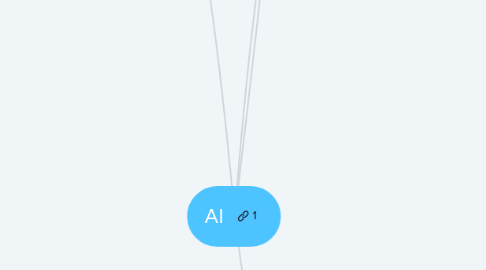
1. Narrow AI
1.1. Speech Recognition
1.1.1. Siri
1.1.2. Alexa
1.1.3. DeepBlue
1.2. Visual Perception
1.2.1. Asimo
1.2.1.1. A fully developed humanoid robot
1.3. Decision Making
1.3.1. Asimo
1.3.1.1. A fully developed humanoid robot
1.3.2. Siri
1.3.2.1. Controls your calls and texts, your everyday tasks, your music, your home, has lots of knowledge, your shortcuts,
1.3.3. Alexa
1.3.4. DeepBlue
1.3.5. IBM Watson
1.3.5.1. It can learn more with less data, protects your insights and re imagines your work flows.
1.3.6. Driverless Cars
1.3.6.1. A car that drives all by itself, like an auto-pilot.
2. Alan Turing
2.1. General Life
2.1.1. 23 June 1912 – 7 June 1954
2.1.2. English mathematician, computer scientist, logician, cryptanalyst, philosopher and theoretical biologist.
2.1.3. During the Second World War, Turing worked for the Government Code and Cypher School (GC&CS) at Bletchley Park, Britain's codebreaking centre that produced Ultra intelligence.
2.1.4. For little while he led the Hut 8, a section that was responsible for German naval cryptanalysis. Here he devised lots of different techniques for speeding up the process of breaking German ciphers, including improvements to the pre-war Polish bombe method, and an electromechanical machine that could find settings for the Enigma machine.
2.1.5. After the war, Turing worked at the National Physical Laboratory, where he designed the ACE. In 1948 Turing joined Max Newman's Computing Machine Laboratory at the Victoria University of Manchester, where he helped to develop the Manchester computers and became interested in mathematical biology. He predicted oscillating chemical reactions such as the Belousov–Zhabotinsky reaction, first observed in the 1960s.
2.2. Death
2.2.1. On 8 June 1954, Turing's housekeeper found him dead. He had died the previous day. A post-mortem examination established that the cause of death was cyanide poisoning.
2.3. Post-War Work
2.3.1. The Turing Test
2.3.1.1. The Turing Test works on the basis of having a conversation with the computer and testing if it was a human, instead of stimulating a complex adult mind, they decided to stimulate a more basic child mind to test it at first. Many ideas have now sprouted out of this, for example the CAPTCHA test is used to determine whether the user is human or a bot
3. Social culture view
3.1. Social/Medical Care
3.1.1. Examples
3.1.1.1. IDx
3.1.1.2. Lumiata
3.1.1.3. Deepmind
3.1.1.4. Project Hanover
3.1.1.5. Telehealth
3.1.1.6. Mabu
3.1.2. Views
3.1.2.1. There are two sides: FOR and AGAINST. FOR are the selection of people who believe that AI should be used in medical research and/or in social care. AGAINST believe that AI should not be used in medical or social care mostly because of unfortunate past experiences or because there may not be enough research in this field of AI just yet...
3.2. Isaac Asimov
3.2.1. American writer and professor of biochemistry at Boston University and is well known for his works of science fiction and popular science. He was president of the American Humanist Association. The asteroid 5020 Asimov, a crater on Mars, a Brooklyn Elementary school and a literary award are named in his honour.
3.2.2. He also created The Three Laws of Robotics a.k.a Asimov's Laws. FIRST LAW - A robot may not injure a human being or, through inaction, allow a human being to come to harm. SECOND LAW - A robot must obey the orders given it by human beings except where such orders would conflict with the First Law. THIRD LAW - A robot must protect its own existence as long as such protection does not conflict with the First or Second Laws.
3.2.3. January 2nd , 1920 - April 6th 1992
3.3. AI films
3.3.1. The Matrix
3.3.2. Avengers: Age of Ultron
3.3.3. Ex Machina
3.3.4. Blade Runner 2049
3.3.5. Ghost in the Shell
3.3.6. Chappie
3.3.7. Iron Man 3
3.3.8. Tron: Legacy
3.3.9. Tau
3.3.10. I, Robot
3.4. Microsoft Tay
3.4.1. Tay was an artificial intelligence chatter bot that was originally released by Microsoft Corporation via Twitter on March 23, 2016; it caused subsequent controversy when the bot began to post offensive tweets through its Twitter account, forcing Microsoft to shut down the service only 16 hours after its launch. According to Microsoft, this was caused by boys who attacked the service as the bot made replies based on its interactions with people on Twitter. It was soon replaced with Zo.
3.5. IBM Watson [Wimbledon]
3.5.1. "We’re helping Wimbledon deliver new levels of engagement for ticket holders and 70 million online fans. Watson-powered real time match reports are expected to rival global outlets in breaking news and uncovering player insights. A voice-activated, Watson-powered digital assistant “Fred,” helps attendees find their way around the venue"
